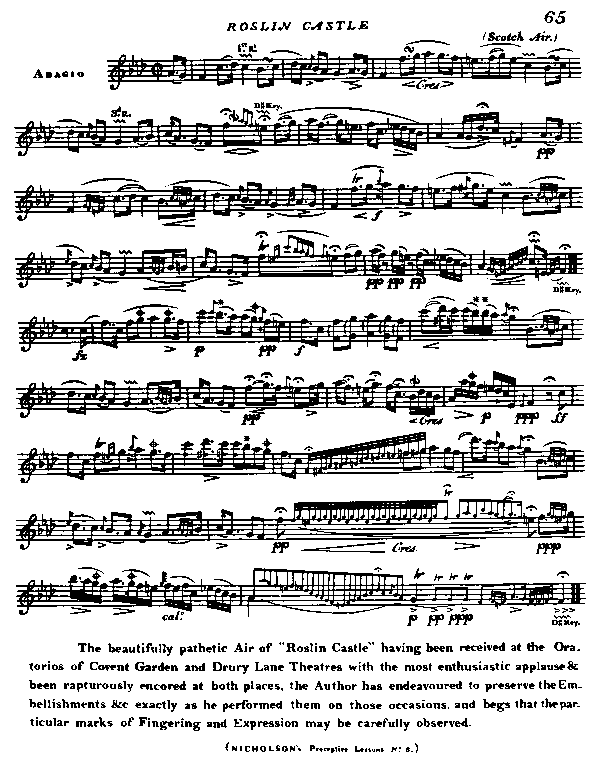
The London flute virtuoso Charles Nicholson (1795–1837) was as popular an idol as any movie star today. His huge tone was admired, but his expression was also extravagently praised. It is possible to imagine that no flutist since has moved his listeners as much.
A taste of Nicholson's style can be gleaned from his arrangement and embellishment of the Scotch air Roslin Castle, which appeared in his Preceptive Lessons for the Flute of 1821. It might be hard to believe that anyone ever played like this, had we not this documentation. When played as he directs, and with feeling and understanding, his arrangement can still speak to and greatly move a modern audience. We make this arrangement available in facsimile form below.
Roslin Castle makes an excellent study in early romantic flute performance practice. This particular style—with many glides, vibrations, and fermatas—is applied by Nicholson primarily to national airs and popular tunes. Harmonic fingerings and those that give narrowed semitones (sensitive fingerings), however, were common practices in all countries in the 1820s and 1830s, and used in all music.

Nicholson played and wrote for the English seven- or eight-keyed flute. A similar instrument is required to follow his instructions exactly, of course. But much of the effect can be obtained on the modern flute, and this is discussed at length in an article by Jan Boland in Flute Talk (December, 1989, pp.11–17), which also contains a modern edition of the piece and notes on performance. Jan has also recorded Roslin Castle on Titanic (Ti-161) on simple-system flute.
Nicholson's notation is explained earlier in the Preceptive lessons. Here is a quick guide for those of us who play simple system flutes.

The crescent shaped mark, as illustrated above, is a glide—a portamento done by more-or-less slowly sliding one or more fingers off their holes. It is performed with a crescendo and care should be used to ensure that the second note is sharp enough. Glides and vibrations (see just below) give a shakuhachi-like effect to passages.
A zigzag line indicates vibration (finger vibrato). The pulsations are to start slowly and intensely, but to increase in frequency as the note dies away. Nicholson recommends that the vibration on c'' be done with RH1, vibration on g' with RH3, and vibration on e' and e'' with the D# key. The c'' is fingered [-2- 456k], i.e. holes 2,4,5,6 closed and the D# key opened. If the recommended fingerings don't seem to give much effect, consider changing the method of blowing and tone until they do—in that way, the flutist might be getting closer to the reedy, focused tone advocated by Nicholson.
The asterisk-like star over a b''b indicates the fingering [12- 456k]. This is an assisted third harmonic of e'b

The notation shown above means that c''' and d'''b are to be played as third harmonics of f' and f'#. The fingering is the same as that of f'' and f''#, whence the notation. The D# key is to be open as well as the F key, for both notes. The c''' can be assisted with hole 2 as a vent hole, but it is not necessary.
A circle with a plus over a g'' indicates the fingering [123' 45,-k] (holes 1 through 5 closed; G#, F, and D# keys open). This is a somewhat veiled note, tending to be sharp. Nicholson recommends this fingering of g'' for use in F minor. It will not work on flutes with the G# key on the lower center joint.
An "x" under f''# means [123 -56k].
An "x" under c'' means [-2- ---k]. This is used in the turn on b'b. It is indicated explicitly at the end of the third staff, but should be used in each of the turns on b'b. The Bb key may remain opened. This c'' would be sharp if stressed, but is hardly touched on in the ornament, which is now easy and smooth. The a' is natural, not flatted, in all such turns.
The slurred octaves are to be performed with the low note first and distinctly heard, but very short (say a thirty-second note, no matter the length of the notes), with the rest of the time given to the upper note. The low note is thus more-or-less an attack or articulation to the upper (main) note.
It can be a surprise to those familiar with 18th and 19th century flutes, on which modes with one or two sharps are the easiest, to learn that the English prefered flat keys! F major was the most common key in the 1820s and the favorite of Charles Nicholson.
It is interesting to note W. N. James' opinion in A Word or Two on the Flute (1826) that the English flute was manufactured to be best in tune in Eb major, a relatively difficult key. Notes in this mode are primarily sounded through tone holes under the keys, and perhaps these notes could be tuned well without the compromises necessary in the tuning of the six uncovered finger holes. These holes served many purposes and were also required to be within reach of the six fingers. The intonation in D major of English flutes from the 1820s and later is sometimes not so easy.
Nicholson asserts that Ab major (and F minor) are capable of great beauty. Thomas Lindsay in his Elements of Flute Playing (1830) associates F minor with melancholy sadness, tenderness, and sorrow. For more comments on keys see the extract from James on the best modes on the flute.
